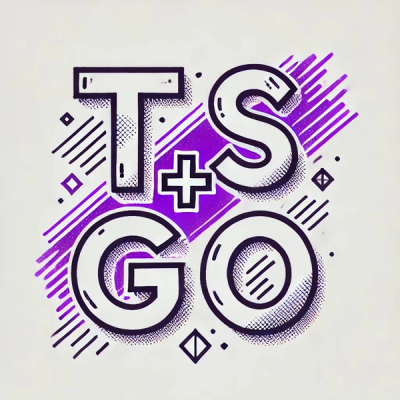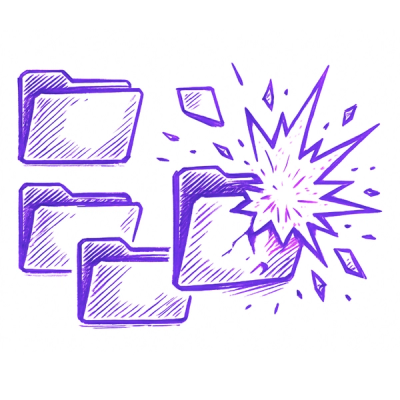In-browser AI
In-browser AI is a TypeScript library that allows you to run modern deep learning models directly in your web browser. You can easily add AI capabilities to your web applications without the need for complex server-side infrastructure.
Features:
- Easy to use. Create a model with one line of code, get the result with another one.
- Powered by ONNX runtime. In-browser AI runs the models using ONNX runtime for Web, which has rich support of all kinds of operators. It means that any model will work just fine.
- Compatible with Hugging Face hub. In-browser AI utilizes model configuration files in the same format as the hub, which makes it even easier to integrate existing models.
Status
The library is under active development. If something does not work correctly, please file an issue on GitHub. Contributions are very welcome.
Continuing work on this project is sponsored by Reflect - awesome app for taking notes.
Model types
Text models
- Sequence-to-sequence (
TextModelType.Seq2Seq). These models are used to transform the text into another text. Examples of such transformations are translation, summarization, and grammar correction.
- Feature extarction (
TextModelType.FeatureExtraction). These models are used to transform the text into an array of numbers - embedding. Generated vectors are useful for semantic search or cluster analysis because embeddings of semantically similar text are similar and can be compared using cosine similarity.
Image models
-
Semantic segmentation (ImageModelType.Segmentation). These models cluster images into parts which belong to the same object class. In other words, segmentation models detect exact shape of the objects in the image and classify them. The example of image segmentation is below.

-
Object detection (ImageModelType.ObjectDetection). These models find objects in the images, classify them, and generate bounding boxes for the objects. The example of the object detection is below.

-
Classification (ImageModelType.Classification). These models do not find exact objects in the images but they only determine what type of object is the most likely in the image. Because of that, this type of models is the most useful when there is only one distinct class of objects present in the image. In the example below, the image is classified as "Egyptian cat".

Installation
The library can be insatlled via npm:
npm install in-browser-ai
Create model instance
Create model from ID
The first way of creating a model is using the model identifier. This method works only for the built-in models.
For text models:
import { TextModel } from "in-browser-ai";
const result = await TextModel.create("grammar-t5-efficient-tiny")
console.log(result.elapsed)
const model = result.model
For image models:
import { ImageModel } from "in-browser-ai";
const result = await ImageModel.create("yolos-tiny-quant")
console.log(result.elapsed)
const model = result.model
Create model from metadata
The second way to create a model is via the model metadata. This method allows to use custom ONNX models. In this case, we need
to use a specific model class. Please note that when creating the model from the metadata, you need to call an init() method before using the model. This is needed to create inference sessions, download configurations files, and create internal structures.
Text models
The metadata for text models is defined by the TextMetadata class. Not all fields are required for the model creation. The minimal example for the Seq2Seq model is:
import { Seq2SeqModel, TextMetadata } from "in-browser-ai";
const metadata: TextMetadata = {
modelPaths: new Map<string, string>([
[
"encoder",
"https://huggingface.co/visheratin/t5-efficient-tiny-grammar-correction/resolve/main/encoder_model.onnx",
],
[
"decoder",
"https://huggingface.co/visheratin/t5-efficient-tiny-grammar-correction/resolve/main/decoder_with_past_model.onnx",
],
]),
tokenizerPath: "https://huggingface.co/visheratin/t5-efficient-tiny-grammar-correction/resolve/main/tokenizer.json",
}
const model = new Seq2SeqModel(metadata);
const elapsed = await model.init();
console.log(elapsed);
The minimal example for the FeatureExtraction model is:
import { FeatureExtractionModel, TextMetadata } from "in-browser-ai";
const metadata: TextMetadata = {
modelPaths: new Map<string, string>([
[
"encoder",
"https://huggingface.co/visheratin/t5-efficient-tiny-grammar-correction/resolve/main/encoder_model.onnx",
],
]),
tokenizerPath: "https://huggingface.co/visheratin/t5-efficient-tiny-grammar-correction/resolve/main/tokenizer.json",
}
const model = new FeatureExtractionModel(metadata);
const elapsed = await model.init();
console.log(elapsed);
Image models
The metadata for image models is defined by the ImageMetadata class. Not all fields are required for the model creation. The minimal example for all image models is:
import { ImageMetadata } from "in-browser-ai";
const metadata: ImageMetadata = {
modelPath: "https://huggingface.co/visheratin/segformer-b0-finetuned-ade-512-512/resolve/main/b0.onnx.gz",
configPath: "https://huggingface.co/visheratin/segformer-b0-finetuned-ade-512-512/resolve/main/config.json",
preprocessorPath: "https://huggingface.co/visheratin/segformer-b0-finetuned-ade-512-512/resolve/main/preprocessor_config.json",
}
Then, the model can be created:
import { ClassificationModel, ObjectDetectionModel, SegmentationModel } from "in-browser-ai";
const model = new ClassificationModel(metadata);
const model = new ObjectDetectionModel(metadata);
const model = new SegmentationModel(metadata);
const elapsed = await model.init();
console.log(elapsed);
Data processing
Text models
The processing is done using a process() method.
Seq2Seq models output text:
const input = "Test text input"
const output = await model.process(input)
console.log(output.text)
console.log(`Sentence of length ${input.length} (${output.tokensNum} tokens) was processed in ${output.elapsed} seconds`)
FeatureExtraction models output numeric array:
const input = "Test text input"
const output = await model.process(input)
console.log(output.result)
console.log(`Sentence of length ${input.length} (${output.tokensNum} tokens) was processed in ${output.elapsed} seconds`)
Image models
For the image models, the processing is also done using a process() method.
Segmentation models output HTML canvas, which can be overlayed on the original image:
const input = "https://upload.wikimedia.org/wikipedia/commons/thumb/8/81/Georgia5and120loop.jpg/640px-Georgia5and120loop.jpg"
const output = await model.process(input)
var destCtx = canvas.getContext("2d");
destCtx.globalAlpha = 0.4;
destCtx.drawImage(result.canvas, 0, 0, result.canvas.width, result.canvas.height,
0, 0, canvas.width, canvas.height);
console.log(output.elapsed)
If you want to determine the class from the output canvas, you can use the getClass() method:
const rect = canvas.getBoundingClientRect();
const ctx = canvas.getContext("2d");
const x = xCoord - rect.left;
const y = yCoord - rect.top;
const c = ctx!.getImageData(x, y, 1, 1).data;
const className = model.instance.getClass(c);
console.log(className);
Object detection models output a list of bounding box predictions along with their classes and colors. Bounding boxes can be used to draw them over the original image:
const input = "https://upload.wikimedia.org/wikipedia/commons/thumb/8/81/Georgia5and120loop.jpg/640px-Georgia5and120loop.jpg"
const output = await model.process(input)
for (let object of output.objects) {
var rect = document.createElementNS("http://www.w3.org/2000/svg", "rect");
rect.setAttributeNS(null, "x", (sizes[0] * object.x).toString());
rect.setAttributeNS(null, "y", (sizes[1] * object.y).toString());
rect.setAttributeNS(null, "width", (sizes[0] * object.width).toString());
rect.setAttributeNS(
null,
"height",
(sizes[1] * object.height).toString()
);
const color = object.color;
rect.setAttributeNS(null, "fill", color);
rect.setAttributeNS(null, "stroke", color);
rect.setAttributeNS(null, "stroke-width", "2");
rect.setAttributeNS(null, "fill-opacity", "0.35");
svgRoot.appendChild(rect);
}
Classification models output an array of predicted classes along with the confidence scores in range [0,1] sorted by confidence in the descending order. When running the process() method, you can specify the number of returned predictions (default is 3):
const input = "https://upload.wikimedia.org/wikipedia/commons/thumb/8/81/Georgia5and120loop.jpg/640px-Georgia5and120loop.jpg"
const output = await model.process(input, 5)
for (let item of output.results) {
console.log(item.class, item.confidence)
}
Built-in models
Text models
Grammar correction
grammar-t5-efficient-mini - larger model for grammar correction (197 MB). Works the best overall.grammar-t5-efficient-mini-quant - minified (quantized) version of the grammar-t5-efficient-mini model. Quantization makes the performance slightly worse but the size is 5 times smaller than the original one.grammar-t5-efficient-tiny - small model for grammar correction (113 MB). Works a bit worse than the larger model but is almost twice smaller.grammar-t5-efficient-tiny-quant - minified (quantized) version of the grammar-t5-efficient-tiny model. Quantization makes the performance slightly worse but the size is 4 times smaller than the original one. It is the smallest model, only 24 MB in total.
t5-efficient-mini - larger model for feature extraction (94 MB). Works the best overall.t5-efficient-mini-quant - minified (quantized) version of the t5-efficient-mini model. Quantization makes the performance slightly worse but the size is almost 3 times smaller than the original one - 38 MB.
Image models
Semantic segmentation
segformer-b0-segmentation-quant - the smallest model for indoor and outdoor scenes (3 MB). Provides a decent quality but the object borders are not always correct.segformer-b1-segmentation-quant - larger model for indoor and outdoor scenes (9 MB). Provides good quality and better object borders.segformer-b4-segmentation-quant - the largest model for indoor and outdoor scenes (41 MB). Provides the best quality.
Classification
mobilevit-small - small model (19 MB) for classification of a large range of classes - people, animals, indoor and outdoor objects.mobilevit-xsmall - even smaller model (8 MB) for classification of a large range of classes - people, animals, indoor and outdoor objects.mobilevit-xxsmall - the smallest model (5 MB) for classification of a large range of classes - people, animals, indoor and outdoor objects.segformer-b2-classification - larger model for indoor and outdoor scenes (88 MB).segformer-b2-classification-quant - minified (quantized) version of the segformer-b2-classification model (17 MB). Provides comparable results with the original.segformer-b1-classification - smaller model for indoor and outdoor scenes (48 MB).segformer-b1-classification-quant - minified (quantized) version of the segformer-b1-classification model (9 MB). Provides comparable results with the original.segformer-b0-classification - the smallest model for indoor and outdoor scenes (13 MB).segformer-b0-classification-quant - minified (quantized) version of the segformer-b0-classification model (3 MB). Provides comparable results with the original.
Object detection
yolos-tiny - small (23 MB) but powerful model for finding a large range of classes - people, animals, indoor and outdoor objects.yolos-tiny-quant - minified (quantized) version of the yolos-tiny model. The borders are slightly off compared to the original but the size is 3 times smaller (7 MB).
Future development
- Improve grammar correction model.
- Extend text models beyond T5.
- Distil Flan-T5-small model to make it more usable in the browser.
- Add audio models (Whisper-small).






